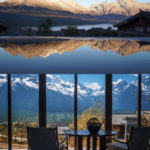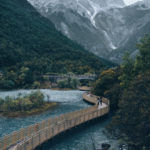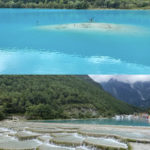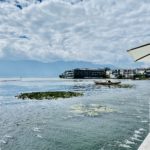Because the new coronavirus stopped me from returning to the U.S., and secondly very thankful that this outbreak has given me more time to stay in China and have time to walk around the country a bit. Coincidentally, I just completed a driving tour of Yunnan with a friend last week.
- First, we went to Lijiang. On the first night, we stayed in an inn in the ancient city of Lijiang. There are many inns in the ancient town, each with its characteristics. The next day, we strolled around Lijiang’s old city, Lijiang ancient city as a minority city, from the town’s overall layout to engineering, architecture melts Han, white, Yi, Tibetan ethnic essence well from the Naxi unique style. The ancient city of Lijiang was not affected by the side of nine miles, next to the three gates, nine meridians, and nine latitudes in the country, through the nine tracks of the Central Plains built the city copy. No rules in the city road network, no city walls, the layout of the ancient city of three mountains for the screen, a river connected; water system using three rivers through the town, family water; street layout meridian set with a song, ghost, narrow, up to the style. The pattern of Lijiang’s ancient city is the spontaneous formation of sitting northwest toward the southeast direction of the form. The Old Town of Lijiang has colorful local ethnic customs and entertainment activities, such as Naxi ancient music, Dongba ceremony, divination culture, the antique town bar, and the Naxi torch festival, unique style. The Old Town of Lijiang embodies ancient Chinese urban construction’s achievements and is one of the distinctive types of Chinese dwellings with specific characteristics and styles.

- Yulong Xueshan: Yulong Xueshan is the nearest equatorial snow mountain range in the northern hemisphere, across the Jiangxi and Zhongdian Xueshan, east and Miamian Mountains, north from the mouth of the Sanjiang River, extending south to latitude 27 ° north, like a fan to the ancient city. The mountain’s 13 peaks from south to north longitudinal arrangement, the main peak fan steep highest elevation of 5596 meters, year-round snow, snow line-height between 4800 ~ 5000 meters. It is the closest temperate marine glacier in Asia and Europe to the equator. Jade Dragon Snow Mountain is called “Oulu” in the Naxi language, which means “Heavenly Mountain.” Its thirteen snow-capped peaks are incessant, resembling a “dragon” soaring and dancing, so it is called “Jade Dragon.” And because its lithology is mainly limestone and basalt, black and white, it is also known as “black and white snow mountain.” It is the Naxi people’s sacred mountain and is said to be the incarnation of the Naxi protector god “San Duo.”
– Ganhaizi
Ganhaizi is located in the Yulong Snow Mountain’s eastern foothills, formerly a high mountain glacial erosion lake. Due to the snow line’s rise, the stagnant water decreased and dried up, known as “dry sea,” which is a highland meadow surrounded by mountains on three sides, the entire considerable meadow length of about 4 km, the width of about 1.5 km.
– Blue Moon Valley
The Yulong Snow Mountain, where the snow and ice melt into a river, is a valley at the eastern foot of the snow mountain because the moon is reflected in the blue sky in the blue lake, and because the valley of the blue moon in the “Vanishing Horizon” by British writer Hilton is similar to this. Therefore, the name “Blue Moon Valley” is derived from the fact that the blue moon is reflected in the blue sky.
The mountains block the river in the Blue Moon Valley from flowing, forming four larger water glasses, known as Yu Liquid Lake, Mirror Pool Lake, Blue Moon Lake, and the Listening Lake. The lakeshore is surrounded by lush vegetation and backed by snow peaks in the distance.
– Baishui River
There is a valley, the valley woods, streams, streams, valley bottom spring long flowing river, called the white water river from the dry sea to the spruce ping. Because the river bed and tableland are made of white marble, charcoal stone fragments were a gray-white; spring from the stone flowing through, was white, because of the color named “white water river.” The water of the White River comes from the meltwater of the glacial snowfield at the height of four to five thousand meters.


3. Dali’s Erhai: Erhai is the “mother lake” of the Bai people, the Bai ancestors called “golden moon,” is a beautiful plateau freshwater lakes, with superior location advantages, remarkable comprehensive function, massive history and culture, right development environment, is the basis for the sustainable development of the economy of Dali Prefecture. The cradle of Dali’s politics, economy, and culture, and also the basis for the sustainable development of the autonomous prefecture’s economy. The clean and transparent surface of the sea is just like the blue sky, which gives people a tranquil and distant feeling and makes them appreciate the poetic and picturesque mood of “boats floating in the blue waves and people swimming in the paintings.” In the southernmost tip of the Erhai, there is an Erhai Park in Tianshan, an excellent place to enjoy Mount Cang and the Erhai.


The point: all attractions in China are now free to medical professionals.